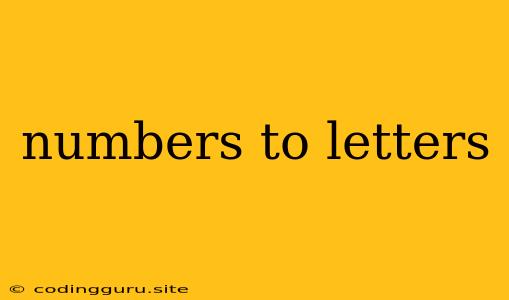Converting Numbers to Letters: A Comprehensive Guide
Have you ever encountered a situation where you needed to transform numerical values into their alphabetical counterparts? This common requirement arises in various scenarios, from creating user-friendly identifiers to generating unique codes. This article delves into the process of converting numbers to letters, offering a practical and comprehensive guide to accomplish this task.
Understanding the Conversion Process
The fundamental principle behind converting numbers to letters involves establishing a mapping between numeric values and alphabetical characters. A typical approach involves assigning each number to a specific letter based on its position in the alphabet. For instance, 1 could represent "A," 2 could represent "B," and so forth.
Methods for Conversion
Several techniques can be employed to achieve this conversion, each with its own advantages and limitations. Let's explore some of the most commonly used methods:
1. Simple Mapping:
This straightforward approach directly assigns a letter to each number. The mapping can be defined through a dictionary, array, or other suitable data structure.
def number_to_letter(num):
letters = {
1: "A",
2: "B",
3: "C",
4: "D",
5: "E",
6: "F",
7: "G",
8: "H",
9: "I",
10: "J",
11: "K",
12: "L",
13: "M",
14: "N",
15: "O",
16: "P",
17: "Q",
18: "R",
19: "S",
20: "T",
21: "U",
22: "V",
23: "W",
24: "X",
25: "Y",
26: "Z"
}
return letters.get(num, "Invalid Input")
# Example usage:
print(number_to_letter(5)) # Output: E
print(number_to_letter(26)) # Output: Z
print(number_to_letter(30)) # Output: Invalid Input
2. Modulo Operation:
For larger numbers, the modulo operator (%) can be effectively used to determine the corresponding letter.
def number_to_letter(num):
letter = chr(ord('A') + (num - 1) % 26)
return letter
# Example usage:
print(number_to_letter(28)) # Output: B
print(number_to_letter(52)) # Output: Z
3. Recursive Function:
A recursive function can handle numbers exceeding the standard 26 letters by repeatedly converting the number into its equivalent letter and reducing it by 26.
def number_to_letter(num):
if num <= 26:
return chr(ord('A') + num - 1)
else:
return number_to_letter(num // 26) + number_to_letter(num % 26)
# Example usage:
print(number_to_letter(30)) # Output: AD
print(number_to_letter(52)) # Output: Z
Tips for Conversion
- Handling Multiple Digits: If you need to convert numbers with multiple digits, apply the chosen conversion method to each digit individually and concatenate the resulting letters. For example, the number 123 could be converted to "ABC."
- Case Sensitivity: Be mindful of whether the conversion should result in uppercase or lowercase letters.
- Zero Handling: Consider how to handle the number zero. You might choose to assign it a specific letter or omit it entirely based on your application.
- Custom Mappings: For specific applications, you might need to create custom mappings that deviate from the standard alphabetical sequence. This could involve assigning specific letters to certain numbers based on your requirements.
Real-World Applications
1. User-Friendly Identifiers: Generate user-friendly identifiers, such as account names or product codes, by replacing sequential numbers with corresponding letters.
2. Data Encoding: Convert numerical data into a more compact or visually appealing representation using letter-based codes.
3. Encryption/Decryption: Implement simple encryption schemes by converting numbers into letters, where each number represents a letter in a specific sequence.
Conclusion
Converting numbers to letters offers a versatile solution for various tasks. By understanding the fundamental principles and exploring different methods, you can effectively implement this conversion within your projects. Whether you're building user-friendly interfaces, encoding data, or developing simple encryption schemes, mastering this technique empowers you to enhance your applications and simplify data representation.
